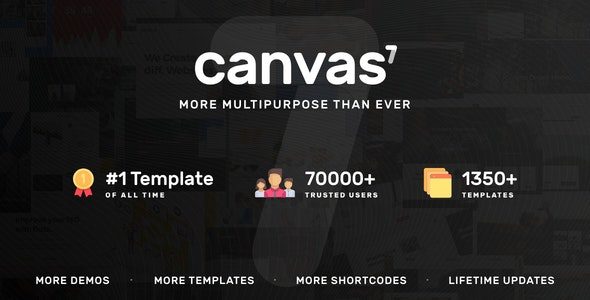28
Here’s a detailed review / breakdown of Canvas 7.2.0 — The Multi-Purpose HTML5 Template (its features, strengths, caveats, and advice) based on available information:
Overview
- Canvas is a multi-purpose HTML5 template (not a WordPress theme) built on Bootstrap 5. ThemeForest+2perfectwpthemes.com+2
- Version 7.2.0 positions it as a mature release with many prebuilt components, layouts, and flexibility. WeaDown+1
- It supports both multi-page and one-page designs. ThemeForest+1
- It includes Dark Mode and RTL (right-to-left) support. ThemeForest+2perfectwpthemes.com+2
Key Features / Capabilities in 7.2.0
From sources (especially the “weadown” listing) and general Canvas marketing material, here are the major features:
| Feature | Details / Extent | Comments |
|---|---|---|
| Blocks & Components | ~220 site blocks included WeaDown | You can mix & match blocks for custom pages |
| Niche / Prebuilt Websites / Templates | Many inner pages, multiple niche templates (blogs, shops, portfolios, events, etc.) WeaDown+2perfectwpthemes.com+2 | Helps accelerate development for many site types |
| Layouts for Portfolios / Blog / Shop | E.g. 170 portfolio layouts, 50 blog layouts, 25 shop layouts claimed in version 7.2.0 listing WeaDown | Good for creative / commerce sites |
| Source / SCSS + CSS Variables | Source SCSS files and CSS variable support for theming/customization WeaDown | Enables easier custom theming |
| Dark Mode / RTL | Full styles for dark mode, plus RTL layouts/styles built in WeaDown+2perfectwpthemes.com+2 | Critical if your audience uses RTL languages |
| JS Plugins / Components | The template includes many JS plugins, functions, etc. WeaDown+1 | Everything from sliders to forms etc. |
| Prebuilt Forms / Contact Pages | Multiple form templates included (30+ contact form templates) WeaDown | Aids in building contact / lead capture quickly |
| Shop / eCommerce Layouts | There are shop / product layout templates included WeaDown+1 | Though note: as purely HTML, integration with backend e-commerce logic must be done by you |
| Responsive + Cross Browser | Template is responsive and intended to work across devices / browsers ThemeForest+1 | Essential for modern web |
Strengths & What Makes Canvas 7.2.0 a Good Choice
- Flexibility: With so many blocks, layouts, and prebuilt templates, you can adapt it for many kinds of sites (portfolio, corporate, e-commerce, blog, etc.).
- Time savings: Because of the many ready modules and pages, you don’t need to build everything from scratch.
- Modern features built-in: Dark mode and RTL are built, which saves you the trouble of retrofitting them later.
- Customizable: SCSS + CSS variables make styling and theming more maintainable.
- Mature / stable: Being at version 7.2.0 suggests it has had several iterations and bug fixes (though you should check change logs).
- Good variety of content templates: Helps when you need a blog, portfolio, shop, events section etc.
Potential Drawbacks / Things to Watch Out For
- Just a front-end template: Because it’s HTML + CSS + JS, you’ll need to integrate backend logic (e.g. for e-commerce, CMS, dynamic content). Canvas won’t handle server logic by itself.
- Overhead / bloat: With many features and components, there might be unused code, which can slow down page loads. You should remove unused parts.
- Learning curve: Customizing deeply (especially JS interactions) might require good frontend skills (JS, CSS, SCSS).
- Maintenance / updates: If the template’s core gets updated, you may need to merge or resolve changes in your custom code.
- Compatibility: New browsers, JS libraries, or CSS standards may introduce breakage; ensure you test thoroughly.
- Support / documentation quality: The usefulness depends heavily on how good the docs are and how responsive the template authors are. Some user reviews praise the documentation. perfectwpthemes.com
- Accessibility: Rich interactive templates sometimes miss a11y best practices (keyboard navigation, ARIA, etc.). You’ll need to check / improve accessibility.
- SEO & dynamic content: For SEO, dynamic content (if integrated later) must be well-structured. The static template gives you HTML structure, but integrating dynamic content needs diligence.
Suitability / Use Cases
Canvas 7.2.0 is a solid fit if:
- You want to build a static / semi-dynamic site (or integrate a backend yourself).
- You need lots of predesigned UI / page types to speed up development.
- You want features like dark mode and RTL without extra work.
- You have front-end development capability (or a developer) to adapt JavaScript, CSS, and integrate with your backend.
It is less ideal if:
- You want a “plug-and-play” CMS solution where you don’t touch code (unless someone wraps this into a CMS).
- You are constrained by performance (you must meticulously select and optimize).
- You need enterprise-level dynamic features out of the box that the template cannot supply.
If you like, I can pull up the full changelog of Canvas up to 7.2.0, compare it with 7.3+ versions to see if you should upgrade, and even suggest alternatives (HTML templates or CMS themes) that might suit your needs. Do you want me to do that?
